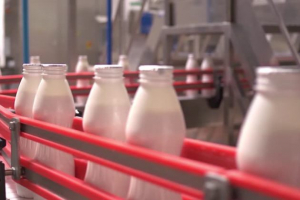An expert from the Bryansk Testing Laboratory of the FGBI “ARRIAH” told how to diagnose brucellosis in animals in the laboratory

Anastasia Borisova, HEAD of the Department of Virology and Molecular Research of the Bryansk Testing Laboratory of the FGBI ARRIAH, talks about the laboratory diagnosis of brucellosis.
What is brucellosis?
Brucellosis (brucellosis) is a predominantly chronic disease, zooanthroponosis, characterized by damage to many life support systems, dysfunction of the vascular, digestive, genitourinary and reproductive systems. The causative agent is Gram-negative facultative intracellular pathogens of the genus Brucella, which are highly resistant in the environment and are able to remain viable for a long time.
Why is brucellosis dangerous?
Infection of people with the pathogen can occur by contact, alimentary route when consuming MILK, fermented milk products, MEAT and meat products obtained from animals with brucellosis and not undergone sufficient heat treatment. Brucella penetrate the body through both damaged skin and mucous membranes. The disease proceeds with the involvement of many organs and systems of the body in the process, causing damage to the bones and joints, and the genitourinary system in people.
In animals, brucellosis most often occurs in a latent form and is manifested by abortions in the second half of pregnancy. Abortions, as a rule, are accompanied by retention of the placenta and the development of mucopurulent, and later purulent-fibrinous endometritis. The defeat of the genital tract entails a violation of the reproductive function, which leads to lethargy, and sometimes infertility.
The disease of brucellosis in some individuals may be accompanied by serous bursitis, hygromas, arthritis, tendovaginitis, and in males - orchitis and epididymitis with a significant increase in the testes and swelling of the scrotum. In pigs, brucellosis is characterized by the appearance of abscesses in the subcutaneous tissue and parenchymal organs, paralysis of the muscles of the pelvis and limbs, and in horses by bursitis.
The source of the pathogen is sick animals, excrement, infected animal care items. Infection occurs alimentary, upon contact with a sick animal, with aborted fetuses, through damaged skin, mucous membranes of the respiratory tract.
How to diagnose brucellosis in animals in the laboratory?
Diagnosis of brucellosis in animals of all types is carried out from the age of 2 months, with the exception of calves of the meat direction of productivity and foals, which are examined from 7-9 months of age, respectively. In the Bryansk testing laboratory of the FGBI “ARRIAH”, serological studies are carried out using the RA, RSK, ELISA methods, and the polymerase chain reaction (PCR) method is also used. Biological material (whole blood, blood plasma, blood serum, milk , contents of the abdominal cavity and stomach, etc.), food, dairy products, cultures of microorganisms, swabs from various surfaces, environmental objects (water, soil, etc.).
Read together with it:
- A Rostov broiler farmer was fined 750,000 rubles for selling meat contaminated with salmonella.The lawsuit against the poultry farm was filed by ROSSELKHOZNADZOR based on the results of an inspection that revealed serious violations of the production process. These included rust on metal structures, which compromised product quality, and unsanitary conditions that facilitated the growth of pathogenic microflora. A batch of Blagoyar pork legs with the backbone proved particularly dangerous, ...
- "Cardboard Superpower." What is Poland prepared to take into 2026?Photo: Unsplash The Polish government has submitted its draft 2026 budget to the Sejm. In short, the hole in the Polish budget is growing even wider, and the national debt is on the verge of skyrocketing. Meanwhile, military spending is breaking records, cementing Poland's status as NATO's leader in defense spending as a percentage of GDP. However, the value of such leadership is questionable. Or ...
- В Приморье владельцу коз вынесено предупреждение за игнорирование ветеринарных мероприятийПо информации управления, владелица частного подворья, Чернуха Г.В., отказалась предоставить для осмотра и проведения ветеринарных процедур 14 коз. Согласно российскому законодательству, владельцы животных несут ответственность за их здоровье и обязаны проводить профилактические мероприятия, направленные на предупреждение болезней. В управляющем органе подчеркивают, что владельцы животных обязаны ...
- Советы по борьбе с опасными заболеваниями животных: страны СНГ предпринимают совместные мерыВ рамках подписанных документов установлены три ключевых направления совместных действий: Профилактика и борьба с бешенством. Профилактика и борьба с ящуром. Профилактика и борьба с гриппом птиц и болезнью Ньюкасла. Цели данных инициатив включают предотвращение распространения заболеваний, снижение экономического ущерба, а также защиту здоровья человека. Реализация этих мероприятий требует координ...
- Belarusian exports of dry milk products to Myanmar quadrupled in the first half of the year.Photo by the Ministry of Agriculture and Food, September 30, MINSK . The first meeting of the Belarusian-Myanmar Joint Working Group on Cooperation in Agriculture and Food was held at the Belarusian Ministry of Agriculture and Food, the ministry told BelTA. The meeting was attended by Deputy Minister Ivan Smilgin, heads of the Ministry's departments, Ambassador Extraordinary and Plenipotentiary of...


